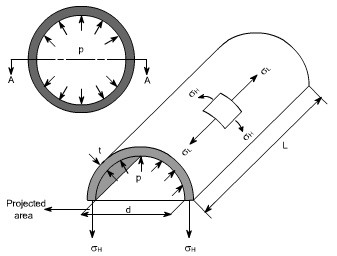What is the relationship between longitudinal stress and circumferential stress:
A. They are the same
B. Longitudinal stress is twice circumferential stress
C. Circumferential stress is twice longitudinal stress
D. There is no fixed relationship between the two
And the answer is…
C. Circumferential stress is twice longitudinal stress
Internal pressure can be produce by water, gases or others. When a thin – walled cylinder is subjected to internal pressure, three are two mutually stresses:
- Circumferential or Hoop stress
- Longitudinal stress
Circumferential or Hoop Stress: This is the stress which is set up in resisting the bursting effect of the applied internal pressure and can be most conveniently treated by considering the equilibrium of the cylinder. The hoop stress is the force exerted circumferentially (perpendicular both to the axis and to the radius of the object) in both directions on every particle in the cylinder wall.
The effect of this may split the pipe into two halves. The failure of the pipe in two halves in fact is possible across any plane, which contains diameter and axis of the pipe. Elements resisting this type of failure would be subjected to stress and direction of this stress is along the circumference.
Longitudinal Stress: Consider a cyclinder that could have closed ends and contain a fluid under a gauge pressure. Then the walls of the cylinder will have a longitudinal stress as well as a circumferential stress.
Considering that the pipe ends are closed and pipe is subjected to an internal pressure ‘P’ the pipe may fail. Elements resisting this type of failure would be subjected to stress and direction of this stress is parallel to the longitudinal direction of the pipe.
Radial stress: Radial stress can also be a factor in thick-walled pipe. It is stress in directions coplanar with, but perpendicular to, the symmetry axis. The radial stress is equal and opposite to the gauge pressure on the inside surface, and zero on the outside surface.



